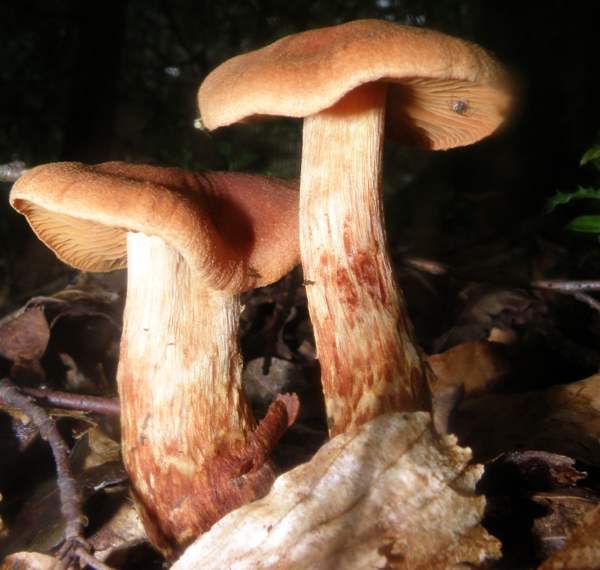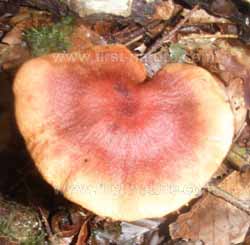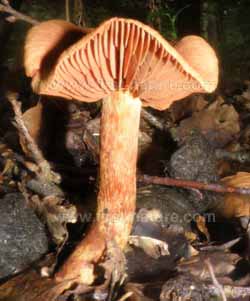Cortinarius orellanus Fr. - Fool's Webcap
Phylum: Basidiomycota - Class: Agaricomycetes - Order: Agaricales - Family: Cortinariaceae
Distribution - Taxonomic History - Etymology - Toxicity - Poisoning - Identification - Reference Sources

Cortinarius orellanus is found from late summer to early winter in woodland. Despite usually being a very different shape, the orange cap of this attractive mushroom has resulted in it being mistaken for Cantharelus cibarius, the highly prized edible chanterelle mushroom - with serious and in many cases fatal consequences.
Distribution
Very rare in Britain and Ireland and rare also in northern parts of mainland Europe, the Fool's Webcap is rather more common in southern Europe.
Taxonomic history
Cortinarius orellanus was described and named by the great Swedish mycologist Elias Magnus Fries in 1838. Its synonyms include Cortinarius rutilans Quel., and Dermocybe orellana (Fr.) Ricken.
Etymology
The generic name Cortinarius is a reference to the partial veil or cortina (meaning a curtain) that covers the gills when caps are immature. In the genus Cortinarius most species produce partial veils in the form of a fine web of radial fibres connecting the stem to the rim of the cap rather than a solid membrane.
Toxicity
Cortinarius orellanus is a deadly poisonous species containing orellanine, a tetrahydroxylated di-N-oxidized bipyridine which, if eaten, rapidly becomes concentrated in the kidneys; untreated it destroys the kidneys and damages the liver. The common name Fool's Webcap could be applied to any of several similar Cortinarius species that have been found to be equally as poisonous.
Poisoning incidents, symptoms and treatment
Despite a very different shape, the orange cap of this attractive mushroom could be mistaken for Cantharelus cibarius, the highly prized edible Chanterelle mushroom - with serious and possibly fatal consequences.
There are several confirmed cases of poisoning associated with Cortinarius orellanus. For example in August 1997 a 66-year-old Austrian woman and her daughter, while holidaying in Ireland, picked mushrooms later identified as Fool's Webcaps, and ate them in a soup. Two weeks later, after suffering abdominal pains, vomiting and diarrhoea, they were hospitalised and the mother was found to have acute renal (kidney) failure. The daughter, who had eaten a smaller amount of the soup, had less severe kidney damage. With dialysis and other medication over many weeks, their lives were saved. What is surprising about this case is that the older woman claimed to have picked wild mushrooms and eaten them over most of her lifetime, and yet she persisted in eating a species which, quite clearly, she had not been able to identify.
Cortinarius rubellus (syn. Cortinarius speciossimus) contains the same toxin; this is the poisonous mushroom collected in mistake for chanterelles by Nicholas Evans, famous author of (among other works) 'The Horse Whisperer' (subsequently made into an acclaimed film by Robert Redford) and 'The Loop. As a result, Mr Evans and three members of his family suffered serious kidney damage and were hospitalised in Scotland. Dialysis and other kidney and liver treatment if received quickly enough can usually save the lives of people who eat these dangerous Cortinarius mushrooms - as it did in the case of Nicholas Evans - but full recovery is a long process.
Identification guide
 |
CapThe tawny-brown to reddish-orange cap is at first convex, flattening at maturity but retaining a slight umbo; its surface is dry and slightly scaly, most noticeably in the centre of the cap. Cap diameter is typically 4 to 7cm when fully expanded, and the margin is usually rolled down. |
 |
GillsThe widely-spaced gills, which are covered by a weakish cortina in young specimens, are pale yellowish at first, becoming red as the spores mature. StemThe stem of Cortinarius orellanus, which is often slightly bowed rather than straight, is usually slightly paler than the cap and sometimes retains fibres from the cortina, mottled with red; it is fibrous and has a curved base that tapers in slightly. Unlike Cortinarius rubellus, the stem of Cortinarius orellanus does not have a pronounced yellowish snakeskin-like surface pattern. The stem is typically 7 to 15mm in diameter and 5 to 10 cm tall. |
SporesEllipsoidal to sub-globose, 9-12.5 x 6.5-8.5μm; with a rough surface. Spore printRusty reddish-brown. |
|
Odour/taste |
Slight smell of radish. DO NOT TASTE EVEN A SMALL PIECE OF THIS MUSHROOM: it is deadly poisonous and even a small amount can cause fatal kidney and liver failure. |
Habitat |
Ectomycorrhizal with hardwood trees (especially oak) and sometimes also under conifers, on both alkaline and acidic soils. |
Season |
August to November in Britain. |
Reference Sources
Fascinated by Fungi, 2nd Edition, Pat O'Reilly 2016, reprinted by Coch-y-bonddu Books in 2022.
Funga Nordica, Henning Knudsen and Jan Vesterholt, 2008.
Dictionary of the Fungi; Paul M. Kirk, Paul F. Cannon, David W. Minter and J. A. Stalpers; CABI, 2008
Taxonomic history and synonym information on these pages is drawn from many sources but in particular from the British Mycological Society's GB Checklist of Fungi.
Acute renal failure from intoxication by Cortinarius orellanus: recovery using anti-oxidant therapy and steroids, Rachael G. Kilner, Richard J. D'Souza, David B. G. Oliveira, Iain A. M. MacPhee, David R. Turner and John B. Eastwood; Nephrology Dialysis Transplantation, Volume 14, Issue 11 (1999) pp. 2779-2780.
Fascinated by Fungi. Back by popular demand, Pat O'Reilly's best-selling 450-page hardback book is available now. The latest second edition was republished with a sparkling new cover design in September 2022 by Coch-y-Bonddu Books. Full details and copies are available from the publisher's online bookshop...

